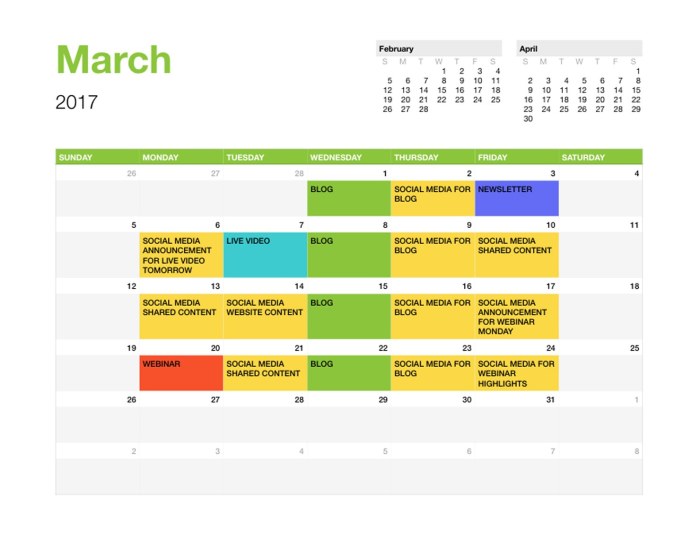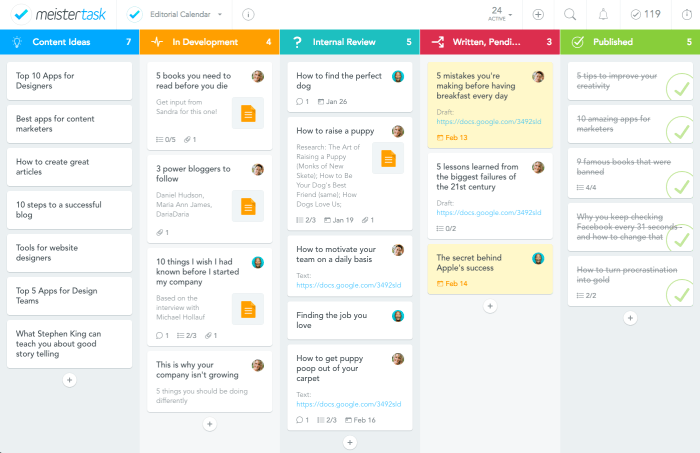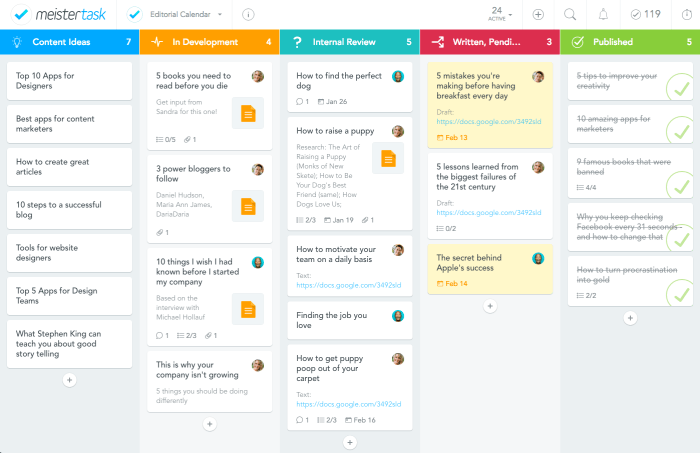Building a Content Calendar sets the stage for this enthralling narrative, offering readers a glimpse into a story that is rich in detail with american high school hip style and brimming with originality from the outset.
Creating a content calendar is the key to unlocking a well-oiled content strategy machine. It’s like having a roadmap to guide you through the exciting journey of content creation and marketing.
Importance of a Content Calendar
When it comes to content creation and marketing, having a content calendar is like having a roadmap for success. It helps you stay organized, plan ahead, and ensure that your content is consistent and relevant to your audience.
Organizing Content Strategy
Using a content calendar can help you plan out your content strategy in advance. By mapping out when and what type of content you will be publishing, you can ensure a steady flow of content that aligns with your overall goals and objectives.
- It allows you to see the big picture of your content strategy and make adjustments as needed.
- Helps in scheduling content for specific events, holidays, or product launches.
- Keeps your team on the same page and accountable for their content contributions.
Consistency is key in content marketing, and a content calendar is your best tool for achieving that.
Benefits of Using a Content Calendar
- Efficiency: With a content calendar, you can plan and schedule your content in advance, saving time and reducing last-minute stress.
- Improved Quality: By having a clear plan in place, you can focus on creating high-quality content that resonates with your audience.
- Track Progress: A content calendar allows you to track your content performance and make data-driven decisions for future content creation.
Elements of a Content Calendar

Creating a well-organized content calendar involves including key components, categorizing content types, and setting publication dates and deadlines to ensure a consistent and effective content strategy.
Key Components of a Content Calendar
- Detailed Content Plan: Artikel the topics, themes, and s for each piece of content.
- Publication Platforms: Specify where each piece of content will be published, such as website, social media, or email campaigns.
- Team Responsibilities: Assign tasks to team members responsible for creating, editing, and publishing content.
- Content Creation Schedule: Establish timelines for content creation, review, and approval processes.
- Analytics and Monitoring: Include tracking mechanisms to evaluate the performance of each piece of content.
Categorizing Content Types
- Blog Posts: Informative articles, how-to guides, and industry insights.
- Social Media Updates: Engaging posts, visuals, and interactive content for various platforms.
- Email Campaigns: Newsletters, promotions, and personalized messages for target audiences.
- Video Content: Tutorials, product demos, and behind-the-scenes footage for visual storytelling.
Importance of Setting Publication Dates and Deadlines, Building a Content Calendar
Setting publication dates and deadlines is crucial for maintaining consistency, meeting audience expectations, and maximizing the impact of content. It helps in planning resources, coordinating team efforts, and optimizing content distribution across different channels. Additionally, having clear timelines ensures timely delivery of content, enhances team accountability, and improves overall content strategy effectiveness.
Creating a Content Calendar
Creating a content calendar from scratch is essential for organizing your content strategy and ensuring consistency in your messaging. Here are some steps to help you get started:
Determining Content Themes and Topics
When determining content themes and topics for your calendar, consider your target audience, industry trends, and your brand’s unique value proposition. Here are some tips to help you brainstorm ideas:
- Conduct research to identify popular topics in your industry.
- Review your competitors’ content to see what is resonating with their audience.
- Consider seasonal trends and holidays that you can tie into your content.
- Solicit feedback from your audience through surveys or social media polls to understand their interests.
Tools for Managing a Content Calendar
To effectively create and manage a content calendar, you can use a variety of tools and software that offer features like scheduling, collaboration, and analytics. Here are some popular tools to consider:
| Tool | Features |
|---|---|
| Google Calendar | Easy-to-use interface, customizable color-coding, and integration with other Google apps. |
| Trello | Visual project management, drag-and-drop interface, and collaboration tools for team members. |
| CoSchedule | Social media scheduling, content optimization, and analytics to track performance. |
Maintaining and Updating a Content Calendar: Building A Content Calendar

Regularly updating and maintaining a content calendar is crucial for the success of any content strategy. It helps in staying organized, ensuring consistency, and adapting to changes in your audience’s preferences and behaviors.
Strategies for Keeping the Calendar Organized
- Set specific times each week to review and update the calendar.
- Use color-coding or different labels to categorize content by type or theme.
- Utilize project management tools or software to track deadlines and assign tasks to team members.
- Regularly communicate with your team to ensure everyone is on the same page and aware of any changes or updates.
Adjusting the Content Calendar Based on Analytics and Feedback
- Regularly monitor key performance indicators (KPIs) such as engagement, traffic, and conversion rates.
- Use analytics tools to identify trends, popular content topics, and areas for improvement.
- Listen to feedback from your audience through comments, surveys, and social media interactions.
- Based on data and feedback, make necessary adjustments to content types, posting frequency, and topics to better resonate with your audience.
